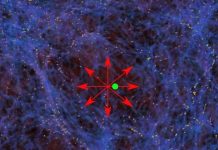
Physicists at MIT have made a significant breakthrough in the field of quantum physics by developing a new method that allows atoms to be positioned much closer together than ever before.
This new technique could lead to the discovery of exotic states of matter and the development of novel quantum materials.
In many quantum experiments, it is crucial for atoms to be as close as possible to each other because their interactions become stronger at shorter distances.
Typically, atoms are arranged using laser light to a distance of about 500 nanometers apart—about half the width of a red blood cell.
However, the MIT team has now successfully positioned atoms just 50 nanometers apart, enhancing their magnetic interactions 1,000 times compared to previous setups.
This groundbreaking work, described in a paper published in the journal Science, was conducted using dysprosium, the most magnetic atom known.
The researchers used a pair of lasers to manipulate two layers of dysprosium atoms, placing them only 50 nanometers apart.
This extreme proximity allowed the scientists to observe new quantum phenomena caused by the intense magnetic forces between the atoms.
One of these phenomena is “thermalization,” where heat transfers from one layer of atoms to another without the atoms physically touching.
Another is synchronized oscillations between the layers, where the vibrations of one layer induce vibrations in the other. These effects diminish as the distance between the layers increases.
Wolfgang Ketterle, the John D. MacArthur Professor of Physics at MIT and a key figure in the research, explained the significance of their approach, stating, “We have gone from positioning atoms from 500 nanometers to 50 nanometers apart, and there is a lot you can do with this.
At 50 nanometers, the behavior of atoms is so much different that we’re really entering a new regime here.”
The researchers achieved this feat by first cooling a cloud of dysprosium atoms to near absolute zero, where the atoms almost completely stop moving.
They then employed two specially tuned laser beams to create a pattern of light that attracts the atoms.
These lasers, each with a different frequency or color and circular polarization, influenced the atoms based on their magnetic spin, aligning them into two separate groups.
To ensure the precise placement of atoms, the team directed the laser beams through an optical fiber, which helped maintain their stability against external disturbances.
This technique allowed the lasers to be overlaid and finely adjusted so that the peaks of their electric fields were just 50 nanometers apart.
The proximity enabled by this new method resulted in magnetic interactions that were formerly negligible becoming significantly powerful. “We could suddenly have magnetic interactions, which used to be almost negligible but now are really strong,” Ketterle noted.
This novel technique not only allows scientists to explore quantum phenomena more deeply but also holds potential for developing new types of quantum computers based on purely magnetic quantum gates.
The research team, including lead author and physics graduate student Li Du, along with colleagues Pierre Barral, Michael Cantara, Julius de Hond, and Yu-Kun Lu, believe that this method could be applied to various other atoms to study a broad range of quantum effects.
They are optimistic about the future applications of their discovery in quantum simulations and other areas of quantum technology.



